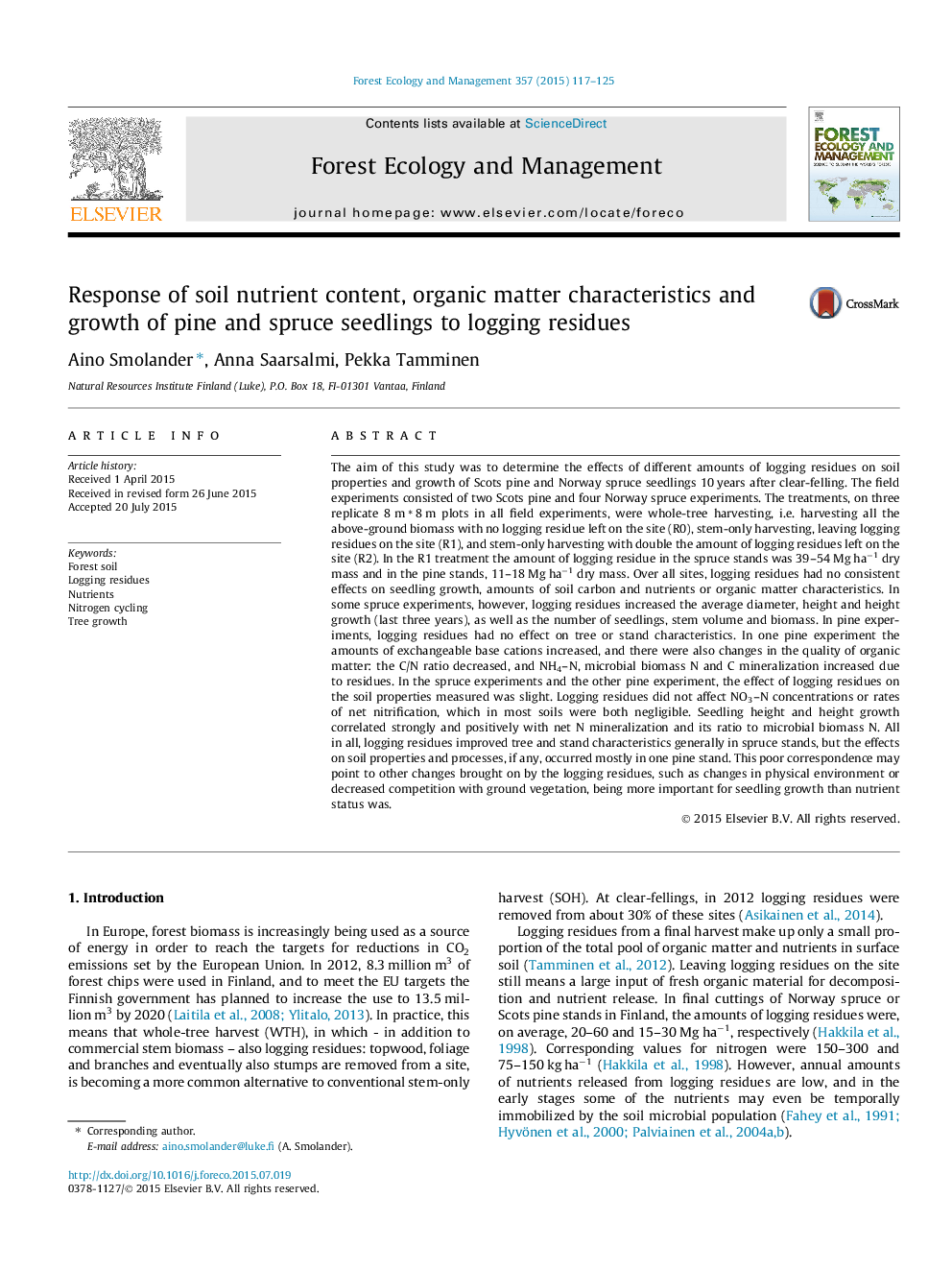| کد مقاله | کد نشریه | سال انتشار | مقاله انگلیسی | نسخه تمام متن |
|---|---|---|---|---|
| 6542703 | 159170 | 2015 | 9 صفحه PDF | دانلود رایگان |
عنوان انگلیسی مقاله ISI
Response of soil nutrient content, organic matter characteristics and growth of pine and spruce seedlings to logging residues
ترجمه فارسی عنوان
پاسخ محتوای مواد مغذی خاک، خصوصیات ارگانیک و رشد نهال کاج و صنوبر برای ثبت معادن
دانلود مقاله + سفارش ترجمه
دانلود مقاله ISI انگلیسی
رایگان برای ایرانیان
کلمات کلیدی
خاک جنگل، پس مانده ها مواد مغذی نیتروژن دوچرخه سواری، رشد درخت،
موضوعات مرتبط
علوم زیستی و بیوفناوری
علوم کشاورزی و بیولوژیک
بوم شناسی، تکامل، رفتار و سامانه شناسی
چکیده انگلیسی
The aim of this study was to determine the effects of different amounts of logging residues on soil properties and growth of Scots pine and Norway spruce seedlings 10 years after clear-felling. The field experiments consisted of two Scots pine and four Norway spruce experiments. The treatments, on three replicate 8 m â 8 m plots in all field experiments, were whole-tree harvesting, i.e. harvesting all the above-ground biomass with no logging residue left on the site (R0), stem-only harvesting, leaving logging residues on the site (R1), and stem-only harvesting with double the amount of logging residues left on the site (R2). In the R1 treatment the amount of logging residue in the spruce stands was 39-54 Mg haâ1 dry mass and in the pine stands, 11-18 Mg haâ1 dry mass. Over all sites, logging residues had no consistent effects on seedling growth, amounts of soil carbon and nutrients or organic matter characteristics. In some spruce experiments, however, logging residues increased the average diameter, height and height growth (last three years), as well as the number of seedlings, stem volume and biomass. In pine experiments, logging residues had no effect on tree or stand characteristics. In one pine experiment the amounts of exchangeable base cations increased, and there were also changes in the quality of organic matter: the C/N ratio decreased, and NH4-N, microbial biomass N and C mineralization increased due to residues. In the spruce experiments and the other pine experiment, the effect of logging residues on the soil properties measured was slight. Logging residues did not affect NO3-N concentrations or rates of net nitrification, which in most soils were both negligible. Seedling height and height growth correlated strongly and positively with net N mineralization and its ratio to microbial biomass N. All in all, logging residues improved tree and stand characteristics generally in spruce stands, but the effects on soil properties and processes, if any, occurred mostly in one pine stand. This poor correspondence may point to other changes brought on by the logging residues, such as changes in physical environment or decreased competition with ground vegetation, being more important for seedling growth than nutrient status was.
ناشر
Database: Elsevier - ScienceDirect (ساینس دایرکت)
Journal: Forest Ecology and Management - Volume 357, 1 December 2015, Pages 117-125
Journal: Forest Ecology and Management - Volume 357, 1 December 2015, Pages 117-125
نویسندگان
Aino Smolander, Anna Saarsalmi, Pekka Tamminen,
